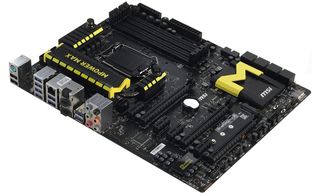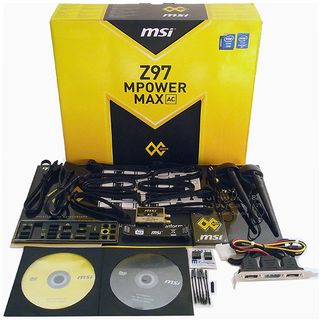Three Z97 Express Motherboards, $220 To $280, Reviewed
MSI Z97 MPower Max AC Hardware
Unlike its namesake, you can really heat things up when you choose Max AC from MSI. And that feeling of performance? Talk about MPowerment! Other than a name that might have been created by a carnival barker, MSI tries to distinguish its Z97 MPower Max AC with features like an Intel “WiDi” 802.11 a/b/g/n/ac BT4.0 combo card, liquid cooling connections on its voltage regulator heat sinks and MSI-exclusive on-board overclocking buttons.

Those liquid cooling connectors are part of what makes this a member of MSI’s “Overclocking” motherboard family, though that feature was missing from a previously-reviewed member of the line-up. Conversely, the cheaper board’s fourth, crippled x16-length expansion slot is missing from this higher-priced version.
MSI also adds a couple of USB 3.0 ports to the Z97 MPower Max AC’s I/O panel, while cutting the number of USB 2.0 ports by the same number. And that means the MPower Max AC gets an extra USB 3.0 controller to help justify its higher price, in addition to the Wi-Fi controller.
The Z97 MPower Max AC has only standard M.2, but that at least beats the one board that doesn’t have any M.2 in this round-up. Its SATA interface is shared with a couple of cable connectors though, reducing available ports from eight to six when that interface is used.

The Z97 MPower Max AC has two USB 3.0 front-panel headers, one that points forward to slide its cable under the top graphics card, and one that faces outward, being located above the top graphics slot. That means both can be used regardless of graphics configuration, and that’s a rarity for this less-flexible connector standard.
Our only possible layout complaint—and it’s a small one—is that the front-panel audio connector is located very close to the Z97 MPower Max AC’s bottom-rear corner. Some cases still come with cables too short to reach there. Even though that’s technically a case problem, we still like to see motherboard designers compensate by moving this header slightly forward.
Otherwise, gamers who’d criticize MSI for not supporting four-way SLI need to remember that the switch everyone else used to get there is about as valuable as the included wireless controller. None of MSI’s competitors implement that, though MSI doesn't support three-way SLI either, since three cards would be split into x8-x4-x4 links. Nvidia doesn’t allow SLI on cards connected with fewer than eight lanes.
Stay on the Cutting Edge
Join the experts who read Tom's Hardware for the inside track on enthusiast PC tech news — and have for over 25 years. We'll send breaking news and in-depth reviews of CPUs, GPUs, AI, maker hardware and more straight to your inbox.
Radeon lovers will point out that three-way CrossFire is still viable, and that x4 bandwidth is still sufficient when connected at four-lane PCIe 3.0 transfer rates.

The Z97 MPower Max AC beats most other competitors by including six SATA cables in its installation kit, and three of those have a right-angle end. Graphics bridges are a different matter though, since the Z97 MPower Max AC lacks three- or four-way SLI support. A single SLI bridge serves its two-way SLI limit. MSI excludes the CrossFire bridge, though some cards include their own and a few others don’t need it.
Intel’s Wi-Fi card is front and center above, mounted on a riser board that fits within the Z97 MPower Max AC’s I/O section.
Current page: MSI Z97 MPower Max AC Hardware
Prev Page Gigabyte Z97X-Gaming GT Software And Firmware Next Page MSI Z97 MPower Max AC Software And Firmware-
Nuckles_56 Damn, nice boards but really expensive. A pity about the i7 4790k not performing well, as I really wanted to see which board was best at OC'ingReply -
InvalidError Seems like somewhat of a shame to test boards with a PCIE switch using only a single GPU. How many enthusiasts who spend in the neighborhood of $300 on a motherboard would settle for a single-GPU setup?Reply
This needs a follow-up with x16x16 PEX vs x8x8 native vs x16x16 LGA2011 and, hopefully, x8x8x8x8 PEX vs x16x8x8x8 native on LGA2011. -
jtd871 On-board wifi is simply a waste of space and power (and probably available pcie bandwidth) - even for mITX mobos. Wireless specifications change too frequently to get locked in to whatever is on your mobo. USB dongles are easier to upgrade/replace and allow more flexibility with respect to antenna placement.Reply
If you really can afford 3 GPUs, you should really be starting with X99. For Z97, full-size ATX boards are kind of a waste due to the limit on available PCIe lanes, unless you want just 1 GPU and a bunch of other 1-2-lane expansion boards. I would have preferred seeing what you can get in a uATX (or possibly mITX) solution for the same budget in a package that's arguably a better fit to cater to the SLI/CF crowd and easier to fit in a case. -
envy14tpe Love to see things at their full potential, but can we include a i5-4690k for comparison? Many people don't need what the i7 offers and would love to see how the i5 overclocks and performs on these motherboards.Reply -
rolli59 Really when it comes down to that class of boards and money is no issue, the question is; is your color theme, red, yellow or blue?Reply -
SessouXFX Anodized Gold. :PReply
That one MSI board...I hope that price isn't accurate, that they're currently out of stock or something else is going on, as in, it's being shipped from S. Korea... -
fl-gators-fan Very nice to see the Gigabyte Gaming GT coming out ahead, as that's the board I'm using. I've had it for about 2 months with the I7-4790K and haven't even tried overclocking yet. The 4.0 GHz is plenty fast for all I do :)Reply -
Gurg So this indicates that for what it costs to try to dress a 4790k up, you will spend at least as much as a higher performing 5820k.Reply -
InvalidError Reply
While the motherboard and CPU may cost about the same, you also need to throw in an extra $100 for DDR4.14541735 said:So this indicates that for what it costs to try to dress a 4790k up, you will spend at least as much as a higher performing 5820k.
Most Popular


